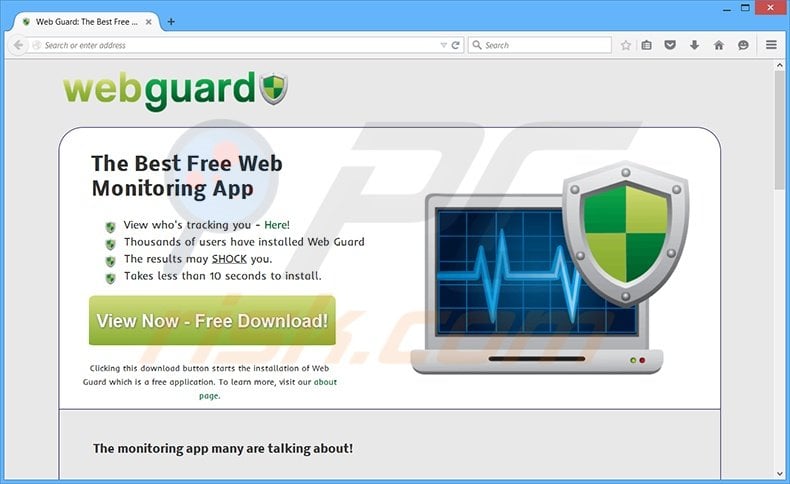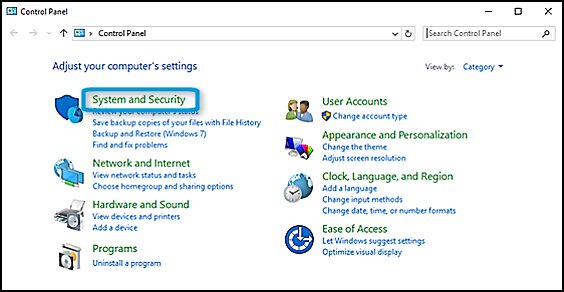2020. 2. 10. 06:09ㆍ카테고리 없음
Web Guard is a browser extension that hits the system in a very tricky manner. Just like a virus, you may just see its presence even for a fact that you did not allow it. Threat Summary Threat Name: Web Guard Type: Malicious Add-on/Extension Brief Description: Malicious add-on or extension can perform various unwanted tasks on computer. Removal Tool: Description Cyber criminals nowadays are using fraudulent means just to gain online profit. One of this is popularly known as Web Guard adware. Adware makers are using tactful strategy to spread and install this potentially unwanted program.
Therefore, it was no surprise if most internet users are facing odds from Web Guard. To be able to know who is tracking you is how it is promoted online.
Pretty nasty stuff. Malware takes place in many forms. Such as Adware, Trojan Horse, Bugs, Ransomware, Spyware, Viruses, and many more. New types of malware is constantly being produced and updated so it is worth getting protected. Trojan Horse. Named after the Trojan Horse legend in Greek Mythology (and the film Troy featuring Brad Pitt, duh). Remove “Ads by Web Guard” virus from Google Chrome Click on Chrome’s main menu button, represented by three horizontal lines ( ).When the drop-down menu appears, select the option labeled Settings.
Virus Web Guard Malwarebytes
Web Guard provide a free set of tools that work to keep your online browsing secured. This is an attractive offer, but its real purpose remains undisclosed. By allowing this adware to remain on the computer, schemers can take full advantage to meet their goals. Web Guard mere objective is to gain revenue by endorsing products and services online. Mind you that they use all means to reach its goal.
Web Guard manages to generate massive online ads that grab your attention. It is known to produce tempting ads after it has gathered all data related to your search queries. Web Guard even collects personal information and private data. Most users find it difficult to deal with Web Guard. Take note that all of these complexities could bring more mess onto your computer.
Plenty of unlikable changes and behaviors are evident in the ways your computer performed overall after Web Guard was loaded. In addition, this unwanted program is widely used by attacker for adware and malicious software distribution. It is also likely to spread virus, malware, and other deadly computer threats. In general, Web Guard is nothing but ad-supported software in which schemers are the only beneficiaries. It is worthless for end users. To be able to stop Web Guard irregularities, and to prevent other severe issues, you must clean the computer using effective virus and malware scanner. Procedures to Remove Web Guard Removal steps on this page will help you get rid of the threat effectively using tools and virus scanners.
Please make sure that you will carry out the guide in exact order. Procedure 1: Uninstall Web Guard from Windows Control Panel 1.
Begin the removal process by uninstalling the adware program from Windows. To do this, we need to open Control Panel. Please ensure that you are logon with the Administrative privilege to access this function. Accessing Control Panel in Windows 8 and Windows 10 - On your keyboard, Press Windows Key + X.
Once Quick Access Menu appears on the screen, please click on Control Panel. Control Panel window will open.
Please proceed to the next step which is uninstalling Web Guard. How to access Control Panel in Windows XP, Windows Vista / 7 - Click on Start button that can be found on bottom left corner of the screen.
From the list, choose Control Panel to access settings of Windows and make the needed changes. Under Programs, click on Uninstall a program. It will open a program and features window where-in you can uninstall, change, or repair installed software. Look for adware title or any suspicious name that was installed recently. To do this, you need to arrange the items chronologically. Click on 'Installed On' to display the latest program that looks unfamiliar.
As observed, this pop-up is also linked to known malware. You may also look for and delete the following names that were identified with Web Guard: Injekt media 4. Select adware relevant to Web Guard or any suspicious items. Then, click on Uninstall button to remove it from Windows. If it prompts for confirmation, please click OK button to proceed. Procedure 2: Scan and remove Web Guard files with MalwareFox Anti-Malware To remove Web Guard, download MalwareFox Anti-Malware.
This tool is effective in getting rid of Trojans, viruses and malware. After downloading, please install the program using the default settings. At the end of the installation, please make sure that it will download necessary updates. Once update has completed, MalwareFox will launch. Click on SCAN button to start the detection process. After thorough scanning, infection result will be displayed.
Remove all threats detected by this anti-malware program after the process. Procedure 3: Scan Computer in Safe Mode Using Installed Anti-virus Program 1. When troubleshooting a PC, one common step is to boot operating system into Safe Mode with Networking. The same approach will be used in the removal of Web Guard.

Please execute instructions based on your Windows OS version. Start Windows 8 / Windows 10 in Safe Mode with Networking - Close all running programs on your computer because we will need to restart Windows on this procedure.
Press and Hold Shift key on your keyboard while clicking on Restart. You will then be presented with Troubleshooting Options. Click on Troubleshoot icon. Then, Click on Advanced Options icon. Select Startup Settings icon and then, Click on Restart button.
When Windows restarts, it will prompt to choose number from the list of options. Press the number on your keyboard that corresponds to Safe Mode with Networking, commonly number 5.
Once in Safe Mode, please proceed to the next step which is running a virus scan on the computer. Start in Safe Mode with Networking (Windows XP / Vista / 7 Instruction) - Please restart the computer and just before Windows start, press F8 on your keyboard repeatedly. You will be presented with Advanced Options Menu. From the selections, choose Safe Mode with Networking. Please use keyboard's arrow up/down to navigate between selections and press Enter to proceed. Once your Windows is running in Safe Mode, open your installed anti-virus programs and update it to the most recent version by automatically downloading necessary updates. Thoroughly scan the computer and remove all identified threats.
Do not restart or turn off the computer after the scan process. You still need to run another scan. Please follow the next procedure. Procedure 4: Run extra scan with Junkware Removal Tool To make sure that no more malicious files linked to Web Guard are inside the computer, we must run another effective scanner. This time, use Junkware Removal Tool. No installation is necessary with this tool. Click the button above to start the download process.
Save the file to your preferred location. Junkware Removal Tool will close all running applications later. So, before executing the file, please Bookmark or Print this page.
And then, close all programs. Double-click the JRT.exe file to initiate the tool. It will prompt you to 'Press any key to continue.' Junkware Removal Tool will create a Restore Point and proceed with the scan. Please wait for the scan process to finish. After scanning the computer, JRT will open a Notepad containing scan logs. It may have not find Web Guard relevant entities, but it will surely delete any malicious items not found in the previous scans.
Procedure 5: Reset Affected Internet Browser Reset browser settings of Google Chrome: 1. Open Google Chrome browser. In the address bar, type this: chrome://settings/ and then, press Enter. Navigate at the end of the page and click on Show advanced settings. At the bottom of the page, click on Reset settings to remove all changes made by Web Guard. Reset Internet Explorer Settings: 1. Open Internet Explorer software.
Navigate to top menu and click Tools Internet Options. On Internet Options window, select Advanced tab. In order to reverse modifications caused by Web Guard, click on Reset button to bring back Internet Explorer's settings to their default condition. Reset Firefox to its default state: 1. Open Mozilla Firefox program. Navigate to top menu and Open Help Menu.
Then, select on Troubleshooting Information. Click on Refresh Firefox button to erase the effect of Web Guard.
Protect your PC from Web Guard or Similar Attack Turn On Safe Browsing Features Google Chrome's Protection from Dangerous Sites With Google Chrome's Dangerous Site Protection feature, you will have lesser risks browsing the web. It will display a warning when the site you are trying to visit is suspicious, thus, you can prevent Web Guard infection. To enable protection from dangerous sites, please do these steps: 1. Open Google Chrome.
In the address bar, type this: chrome://settings/ and then, Press Enter. Once on the settings page, click on Show advanced settings. At the bottom of the page to see the rest of the Chrome setup. Locate Privacy section and mark ' Protect you and your device from dangerous sites'. Please restart Google Chrome.

New settings keep your browser safe while surfing the web. : Enable Google Chrome's protection from dangerous sites Internet Explorer - Activate SmartScreen Filter Internet Explorer versions 8 and 9 has this feature called SmartScreen Filter. It helps detect phishing web sites and protect you from downloading malicious programs including Web Guard.
To turn on SmartScreen Filter, follow these steps: 1. Please open Internet Explorer.
On top menu, select Tools (IE 9). For IE 8, please look for Safety menu. Select SmartScreen Filter from the drop-down list and click on Turn on SmartScreen Filter. Please restart Internet Explorer. : Comprehensive steps to activate SmartScreen Filter Mozilla Firefox - Block Attack Sites and Web Forgeries Phishing and Malware Protection is a built-in feature on Firefox version 3 or later. It warns you when a page you are trying to visit contains phishing content or an attack site designed to drop threats such as Web Guard.
To help you keep safe while browsing the Internet using Firefox, please follow this guide: 1. Open Mozilla Firefox browser. On top menu, click on Open Menu. Then select Options from the list.
Select Security and put a check mark on the following items:. Warn me when sites try to install add-ons. Block reported attack sites. Block reported web forgeries Edge Browser - SmartScreen Filter SmartScreen filter is a built-in feature in Microsoft Edge browser that can help you deter malicious programs such as Web Guard.
It can block malicious web sites and downloads. Open Microsoft Edge browser.
Click on More Actions button located at top right corner of the screen. Select Settings from the drop-down list. Under Settings menu, go to Advanced Settings section and click on View Advanced Settings.
Scroll down to ' help protect my PC from malicious sites and downloads with SmartScreen Filter'. Turn it to ON. 6.You may now restart Microsoft Edge browser.